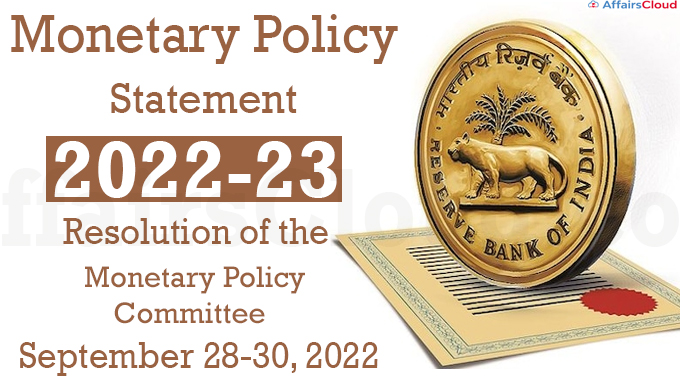 The Reserve Bank of India’s (RBI) Monetary Policy Committee (MPC) met on September 28-30, 2022 , and released the 4th RBI’s bi-monthly monetary policy of FY23 which decreased India’s Gross Domestic Product (GDP) growth for FY23 to 7% from 7.2% with FY23’s Q2 at 6.3%; Q3 at 4.6%; and Q4 at 4.6%. The reason behind this downward revision is geopolitical tensions, tightening global financial conditions and slowing external demand.
The Reserve Bank of India’s (RBI) Monetary Policy Committee (MPC) met on September 28-30, 2022 , and released the 4th RBI’s bi-monthly monetary policy of FY23 which decreased India’s Gross Domestic Product (GDP) growth for FY23 to 7% from 7.2% with FY23’s Q2 at 6.3%; Q3 at 4.6%; and Q4 at 4.6%. The reason behind this downward revision is geopolitical tensions, tightening global financial conditions and slowing external demand.
- The stance is to focus on withdrawal of accommodations.
- The GDP growth for Q1FY24 is projected at 7.2%.
- RBI has now raised rates by a total of 190 basis points since its first unscheduled mid-meeting hike in May 2022
Inflation:
Inflation is projected at 6.7% in FY23, with Q2 at 7.1%; Q3 at 6.5%; and Q4 at 5.8%, and risks are evenly balanced.
- CPI inflation for Q1FY24 is projected at 5%.
RBI’s Policy Rates:
The MPC raised the repo rate for the 4th consecutive time by 50 basis points to 5.90% from 5.40%. Consequently, the Standing Deposit Facility (SDF) Rate adjusted to 5.65% from 5.15%; and Marginal Standing Facility (MSF) rate and Bank Rate to 6.15% from 5.65%.
| Category | Rate |
|---|---|
| Policy Repo Rate | 5.90% |
| Reverse Repo Rate | 3.35% |
| Standing Deposit Facility (SDF) Rate | 5.65% |
| Marginal Standing Facility (MSF) Rate | 6.15% |
| Bank Rate | 6.15% |
| Cash Reserve Ratio (CRR) | 4.50% |
| Statutory Liquidity Ratio | 18% |
Domestic Economy:
i.India’s real GDP grew year-on-year (y-o-y) by 13.5% in Q1:2022-23.
ii.Gross Value Added (GVA) rose by 12.7% in Q1:2022-23, with all constituents recording y-o-y growth and most notably, services.
iii.CPI (Consumer Price Index) inflation rose to 7% (y-o-y) in August 2022 from 6.7% in July as food inflation increased.
iv.Overall system liquidity remained in surplus, with the average daily absorption under the liquidity adjustment facility (LAF) easing to Rs 2.3 lakh crore during August-September 2022 from Rs 3.8 lakh crore in June-July 202.
v. As on September 9, 2022, money supply (M3) expanded y-o-y by 8.9%, with aggregate deposits of commercial banks growing by 9.5% and bank credit by 16.2%.
vi.The Current Account Deficit (CAD) for Q1FY23 is placed at 2.8% of GDP with trade deficit at 8.1% of GDP.
- In FY22, the CAD had stood at 1.2% of the GDP.
External Financing:
i.As on September 23, 2022, India’s foreign exchange reserves were placed at US$ 537.5 billion.
ii.India’s net foreign direct investment (FDI) improved to US$ 18.9 billion in April-July 2022 from US$ 13.1 billion in April-July 2021.
iii.Foreign portfolio investors (FPIs) showed a net inflow of US$ 7.5 billion during July-September 2022 after an outflow for nine consecutive months.
iv.India’s External Debt to GDP ratio is the lowest among major EMEs (Emerging Market Economies).
RBI may adopt ‘Expected Loss’ approach for Banks’ Loan Provisioning
RBI may consider the ‘expected loss’ approach for loan provisioning by banks as compared to the present ‘incurred loss’ approach, where money is set aside after a loss from an asset.
- In this regard, RBI will release a discussion paper on ‘expected loss-based approach’ for stakeholders’ comments.
Key Points:
i.The ‘expected loss’ approach i.e. to make provisions or set aside money on the probable losses is a globally accepted prudent norm.
ii.At present, larger non-bank lenders have already been using the expected loss approach for provisioning since 2018.
Discussion Paper on Securitization of Stressed Assets Framework (SSAF):
RBI will also introduce a framework for Securitization of Stressed Assets Framework (SSAF). This will provide an alternative mechanism for securitization of NPAs (Non-Performing Assets) in addition to the existing ARC (Asset Reconstruction Companies) route
- Currently, Securitization and Reconstruction of Financial Assets and Enforcement of Security Interest (SARFAESI) Act, 2002 provides a framework for securitization of NPAs to be undertaken by Asset Reconstruction Companies (ARCs) licensed under the Act.
- RBI will soon issue the discussion paper for the same.
RBI to stop 28-day VRRR, will continue with 14-day auctions
The 28-day Variable Rate Reverse Repo (VRRR) auctions will be stopped by the RBI due to current banking system liquidity conditions. However, 14-day VRRR auctions will be continue. This means 28-day VRRR will be merged with 14-day VRRR.
Key Points:
i.India’s banking system liquidity slipped into deficit in September 2022 which currently stands at a deficit of RS 187 billion ($2.29 billion).
ii.The RBI has been conducting 28-day VRRR auctions for Rs 500 billion since November 2021, but these auctions have not been fully subscribed for the last few months.
- This measure is expected to bring in regulatory synergy and convergence on data standards
RBI to ease net banking norms for customers of RRBs
RBI also proposed to ease norms for internet banking for customers of Regional Rural Banks (RRBs).
- Presently, RRBs are allowed to provide Internet Banking facility to their customers with prior approval of the RBI, subject to fulfilment of certain financial and non-financial criteria.
- Now in order to promote the spread of digital banking in rural areas, the criteria for RRBs to be eligible to provide internet banking will be rationalized.
Key Point:
RRBs with a net worth of 1 bln rupees can provide internet banking facility, according to the guidelines issued in 2015. They must also have the capital adequacy ratio of not less than 10%. The gross and net bad loan ratio should be less than 7% and 3%, respectively.
RBI also released the monetary policy report which is published under Section 45ZM of the Reserve Bank of India (RBI) Act, 1934. Click Here to access.
Members of MPC:
Dr. Shashanka Bhide; Dr. Ashima Goyal; Prof. Jayanth R. Varma; Dr. Rajiv Ranjan; Dr. Michael Debabrata Patra; and headed by Shaktikanta Das (RBI Governor).
About Reserve Bank of India (RBI):
i.The Reserve Bank of India was established on April 1, 1935, in accordance with the provisions of the Reserve Bank of India Act, 1934.
ii.The Central Office of the Reserve Bank was initially established in Calcutta but was permanently moved to Mumbai in 1937.
iii.Though originally privately owned, since nationalization in 1949, the Reserve Bank is fully owned by the Government of India.




